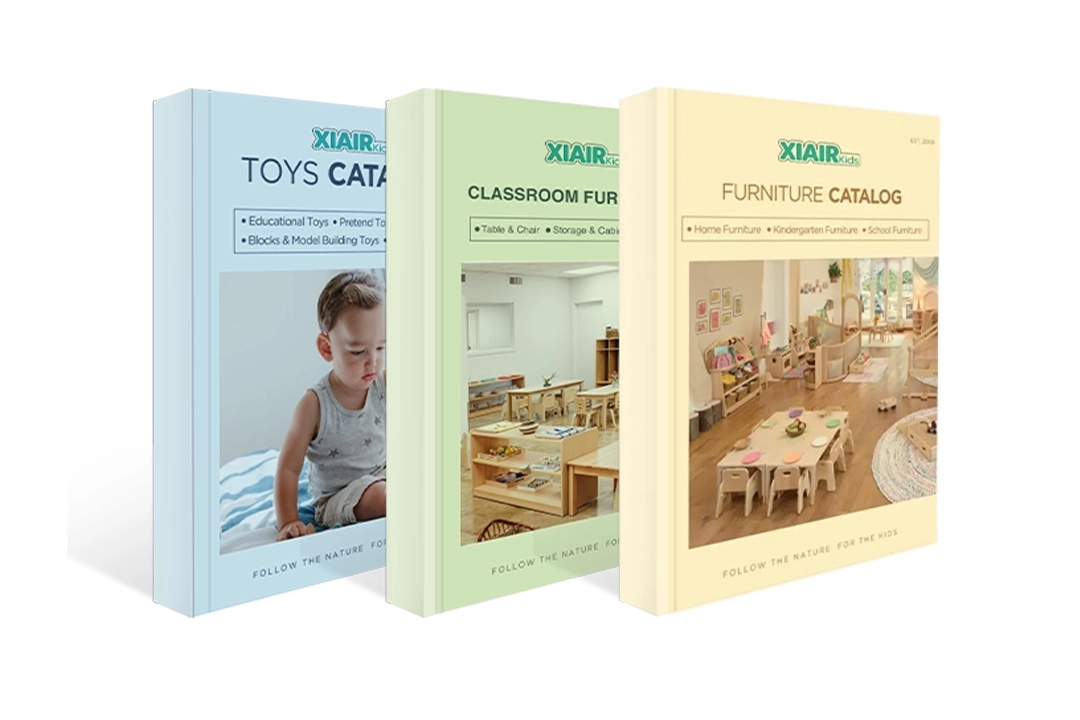Are you struggling to design a Montessori bedroom that genuinely works for your child’s development? Does your baby’s bedroom feel more like a Pinterest board than a space where they can grow, explore, and rest independently? Maybe you’ve heard of Montessori nurseries or Montessori infant rooms — but translating those ideas into your home feels overwhelming or confusing?
A Montessori bedroom is more than a design trend — it’s a practical, child-focused environment that supports independence, order, and freedom of movement. Whether setting up a Montessori nursery for your newborn, an infant bedroom, or transitioning into a Montessori toddler room, the proper setup empowers your child to learn through daily routines, safe exploration, and purposeful play.
In this guide, I’ll show you exactly how to build a Montessori bedroom that fits your child’s needs and your home’s space — from essential Montessori bedroom furniture to fundamental infant bedroom ideas and toy setups. Get ready to create a Montessori room that supports learning, calm, and confidence from when your child wakes up.
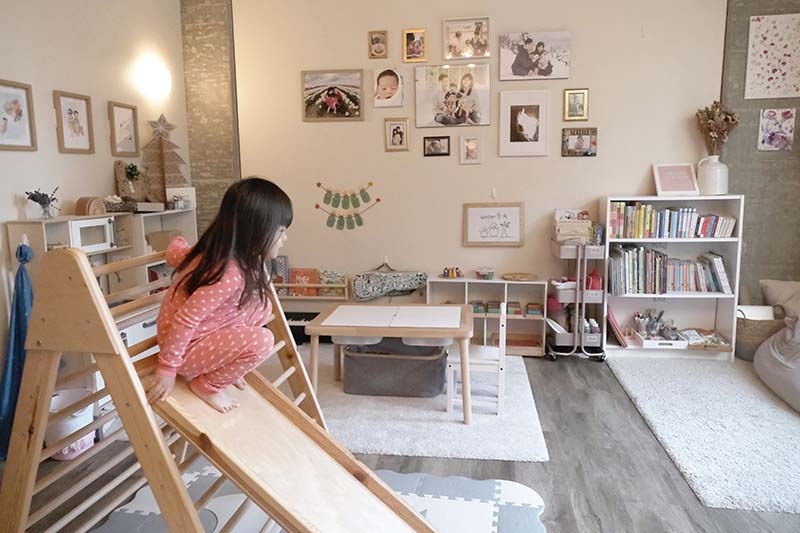
What is a Montessori Bedroom?
A Montessori bedroom is a carefully prepared space to support a child’s natural development, independence, and curiosity. Rooted in the principles of Montessori education, it shifts the focus from adult-centered design to a child-led environment that encourages exploration, autonomy, and learning through daily routines.
Instead of the traditional baby’s bedroom setup — where cribs, high shelves, and decorative clutter dominate — a Montessori room is designed at the child’s level. Furniture is low and accessible. Toys are few but purposeful. Décor is calming, not distracting. The layout allows a child, even an infant, to interact safely with their surroundings.

In a typical Montessori infant room, you’ll find a floor bed instead of a crib, open shelves with simple toys, a mirror placed at floor level, and a soft area rug that gives the baby freedom to move and explore. As the child grows into toddlerhood, the space evolves with them — becoming a Montessori toddler room that includes child-sized furniture, a dressing area, and areas for play and concentration.
The core philosophy is simple: the environment should serve the child. This room isn’t designed for adults to admire but for children to live, move, rest, and grow independently.
Non limitarti a sognarlo, progettalo! Parleremo delle tue esigenze di arredamento personalizzato!
What are the benefits of a Montessori baby room?
A well-designed Montessori baby room does more than look good — it shapes your child’s early development. From the very first months of life, a thoughtfully prepared Montessori infant room gives your child the freedom and security to explore, grow, and build confidence in their abilities.
1. Encourages independence from day one
One of the primary benefits of a Montessori bedroom is that it promotes independence. From the moment a child begins to move — whether rolling, crawling, or walking — the room supports their need for safe, self-directed exploration. Items like the Montessori floor bed allow even infants to get in and out of bed independently, helping them learn to listen to their bodies when they’re tired or awake, instead of relying on an adult to lift them in and out of a crib.
2. Supports natural motor development
An actual Montessori baby room isn’t packed with baby gear that restricts movement. Instead, it offers open floor space, soft rugs, and mirrors at baby height — elements designed to stimulate movement and coordination. The play or movement area in a Montessori setup is vital during the first year, encouraging tummy time, crawling, pulling up, and more.
3. Builds a sense of order and routine
Montessori rooms are intentionally minimal. You won’t find an explosion of toys or bright, overstimulating colors. Instead, the environment is peaceful and predictable. When everything has a place — from toys to clothes — children quickly learn to clean up after themselves and build early organizational habits. This sense of order also helps support a daily routine for newborns, reducing stress and overstimulation during sleep and play times.
4. Nurtures emotional security
Montessori emphasizes respect for the child; nothing communicates respect like designing a space just for them. When children know where everything is and feel capable of navigating their room alone, they feel safe and confident. A well-prepared Montessori nursery gives your child a sense of ownership over their space, helping them feel more secure in their environment.
5. Builds responsibility and confidence
Your child learns to make choices with everything within reach — from books to clothes to toys. These small decisions build independence, problem-solving skills, and self-confidence. Whether picking a book for quiet time or choosing their outfit from a low-hung wardrobe, your child learns daily by interacting with their environment.
A Montessori bedroom for infants doesn’t need to be elaborate or expensive. Even the simplest room — designed intentionally — can offer huge developmental benefits. The key is to build a space that says to your child: “I trust you. This is your space. You belong here.”

The Best Montessori Bedroom List
Less is more when setting up a Montessori bedroom — but every item should be chosen intentionally. Here’s a simple list of essential furniture and accessories that make a Montessori room functional, safe, and developmentally supportive.
These items work for various age stages, from Montessori newborn to Montessori toddler room setups.
- Floor Bed: A low mattress or bed frame that allows your child to get in and out independently, encouraging freedom of movement and safe exploration.
- Child-Sized Furniture: Chairs, tables, and wardrobes scaled to your child’s height, making everyday tasks like dressing and sitting accessible.
- Low, Wide Shelves: These display toys and books at eye level, helping your child choose activities independently and develop a sense of order.
- Toddler-Friendly Storage: Open bins or baskets for organizing toys and clothes; easy for little hands to use, which supports cleanup routines and responsibility.
- Simple Decor: Neutral colors, soft lighting, and natural textures create a calm, focused space that avoids overstimulation and promotes restful sleep.
With just these elements, your Montessori room will be beautiful and developmentally rich — a space where your child can play, rest, and grow confidently.
Letto a terra


A Montessori floor bed is one of the most essential elements in a Montessori bedroom, and for good reason. Unlike cribs that limit movement, floor beds promote freedom, independence, and self-regulation from an early age.
Placing a simple mattress on the floor works fine if you’re on a budget. Want something with a bit of style? Plenty of framed floor bed designs are available — from sleek minimalist looks to playful house-shaped frames that turn your child’s Montessori bedroom into a cozy retreat.

La tua classe perfetta è a un clic di distanza!
Dressing Area
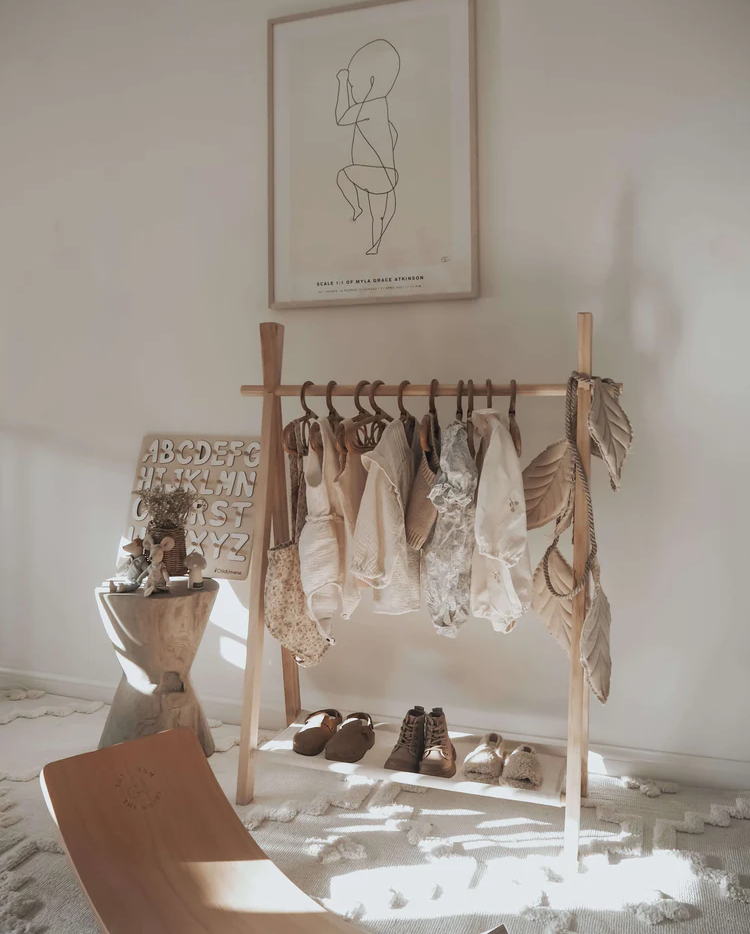
In a Montessori bedroom, the dressing area isn’t just about clothes — it’s about helping your child learn responsibility, independence, and daily life skills.
You only need a child-sized wardrobe, low hooks, or a simple basket system for folded clothes. Some families use a small open shelf or rail at toddler height to hang a few outfit options — making morning choices easy and stress-free.
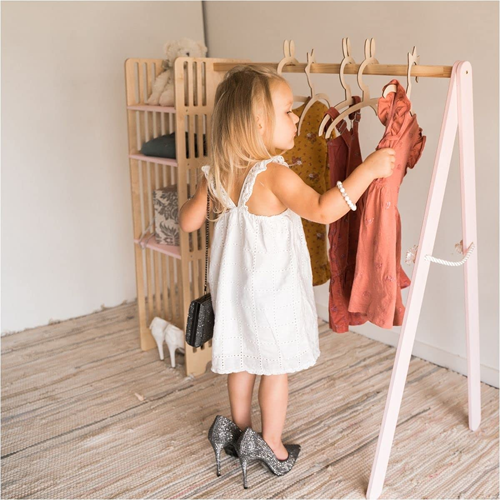

Feeding Area
While feeding usually happens in the kitchen or dining room, having a small, toddler-accessible feeding area in or near the Montessori bedroom can help support your child’s independence — especially during early mornings or quiet snack times.
A simple setup includes:
- A child-sized table and chair
- A small shelf or tray with healthy, pre-prepared snacks
- A water dispenser or cup placed at toddler height
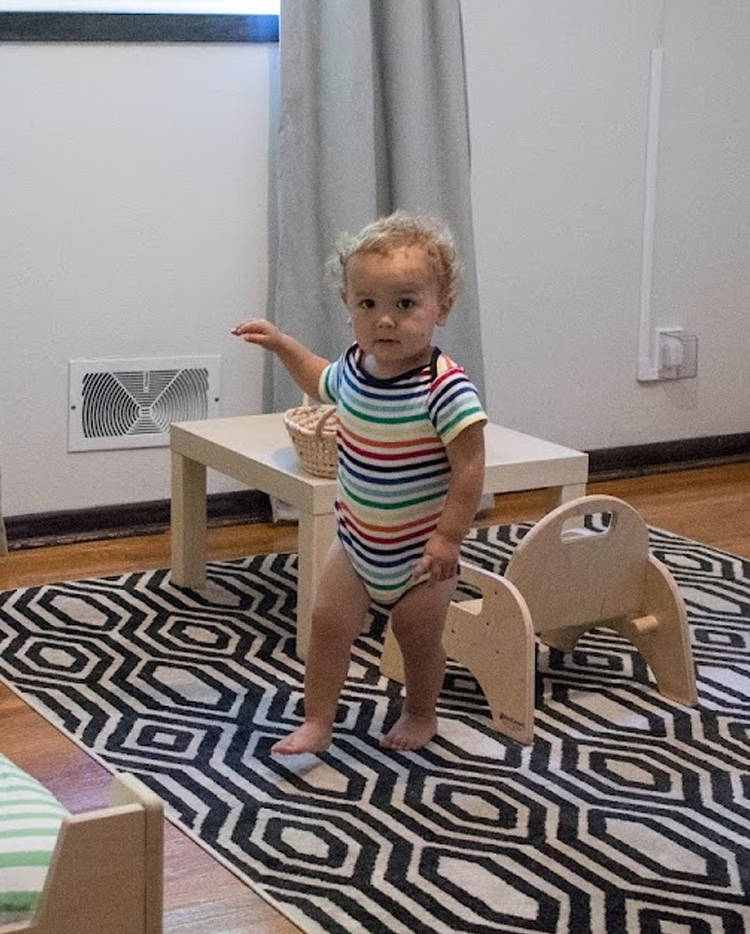
Play or Movement Area
A well-prepared play or movement area is a core part of any Montessori bedroom, especially for infants and toddlers. This is the space where your child builds motor skills, explores their environment, and engages in self-directed play — all key elements of Montessori development.
You don’t need a lot of space. Even a corner of the room can be transformed into an effective Montessori play zone with:
- A soft rug or mat for rolling, crawling, or stretching
- A low mirror mounted horizontally at floor level to encourage body awareness
- A simple shelf with a few rotating toys — think stacking rings, wooden puzzles, or fabric balls
- An open space free from clutter, allowing free movement and safe exploration
This setup is essential in a Montessori infant room, where babies are just starting to explore their bodies and surroundings. As your child grows, the same space can evolve into an area for building, pretend play, or focused activities.

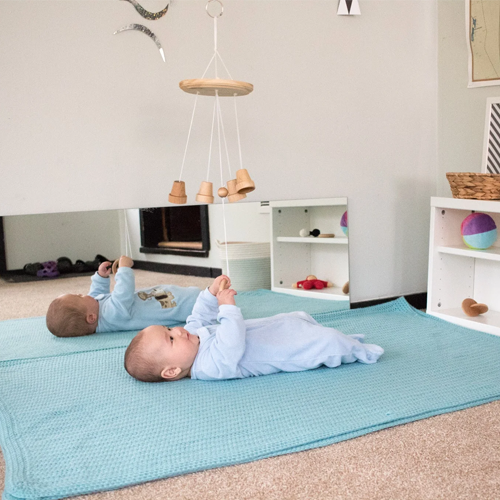
La tua classe perfetta è a un clic di distanza!
Low Shelf with Toys


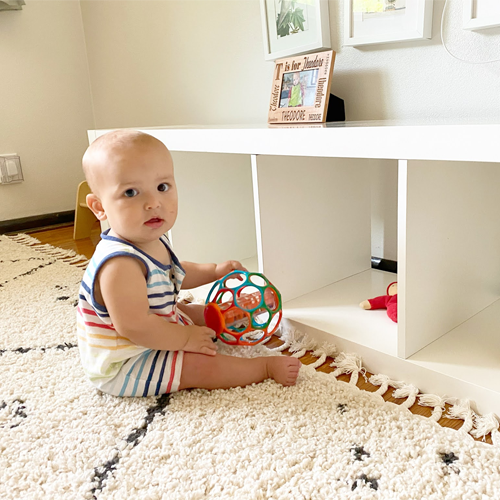
A low shelf with toys is a key feature in every Montessori bedroom. It’s simple, practical, and powerful, allowing your child to see, choose, and return toys independently. This small setup teaches decision-making, order, and responsibility from an early age.
The shelf helps foster independence. Your child doesn’t need to ask permission — they can walk up, choose something meaningful, and play purposefully.
Montessori Books
Including books in your Montessori bedroom setup is a great way to support early language development and quiet time. You don’t need an extensive collection — just a few carefully chosen books at your child’s level.
A small front-facing bookshelf or a low basket with 4–6 books is ideal. For infants, choose durable board books or even wooden or cloth books that are safe to explore. Toddlers can enjoy simple stories with real-life images and everyday themes.
Keep the setup tidy, rotate books regularly, and create a cozy spot nearby with a cushion or soft rug. It’s a slight touch that makes a significant impact.


Recommended titles include Global Babies, Hands Can, Eating the Rainbow, E Whose Tools? — all beautiful examples of Montessori-aligned literature.
Tips to Build the Best Montessori Bedroom
A Montessori bedroom is naturally beautiful when it reflects simplicity, order, and your child’s personality. You don’t need fancy decorations or a big budget — just thoughtful design choices supporting development and aesthetics. Here’s how to create a space that’s not only functional, but also visually calming and child-centered.
Lighting
Natural light is ideal in a Montessori bedroom. Keep windows unobstructed to let daylight in, and choose soft, warm lighting for the evenings. Avoid bright overhead lights or flashy nightlights. Soft lamps at low levels help create a calm, cozy atmosphere that supports sleep and quiet time.
Color Palette
Choose soft, neutral colors that create a sense of calm — think warm whites, soft beiges, light greys, dusty pinks, or muted greens. Avoid bright primary colors or loud patterns, which can be overstimulating. A natural color scheme helps the room feel peaceful and supports better rest, especially for infants and toddlers.
Artwork
Montessori-style artwork should be simple, realistic, and placed at your child’s eye level. Think nature prints, real-life animals, or family photos. The goal is to inspire calm interest and help your child connect with the world around them — not to overstimulate.
Simple and Orderly
Simplicity is a core Montessori value. Keep the space clutter-free with just a few well-chosen toys, books, and furniture pieces. Everything should have its place — this teaches your child order and responsibility while making the room visually peaceful.

Natural Materials Are Best
Opt for natural elements like solid wood furniture, cotton bedding, and woven baskets. These materials are durable, eco-friendly, and offer a warmer, more grounded feeling than plastic or synthetic alternatives.
Pay Attention to Texture and Details
Babies and toddlers explore the world through touch, so use a variety of textures: soft rugs, smooth wooden toys, linen curtains, and wool blankets. Well-made furniture with rounded edges and thoughtful finishes adds beauty and safety to the room.
Follow Your Child’s Likes and Interests
A beautiful Montessori bedroom reflects your child’s unique personality. Include items that matter to them — a favorite stuffed animal on the floor bed, a shelf with their current interests, or a few framed drawings they’ve made. When the room feels personal, your child feels more at home and at peace.
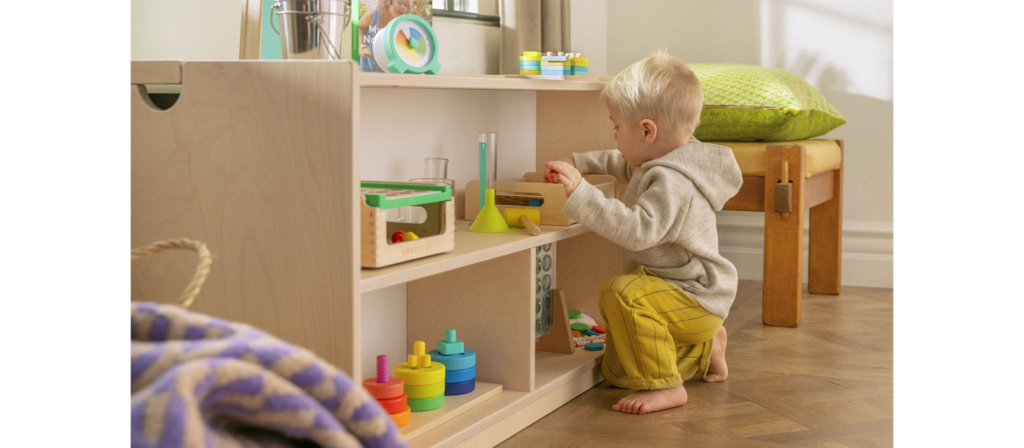
Considerazioni sulla sicurezza
Creating a Montessori bedroom that promotes independence also means creating a space that’s 100% safe for your child to explore freely. Safety must be at the core of your setup since your little one will have full access to their environment — thanks to features like the Montessori floor bed, low shelves, and child-sized furniture.
Here are the most important safety considerations to keep in mind:
Secure Furniture and Wall Decor
All shelves, wardrobes, and mirrors should be securely anchored to the wall to prevent tipping. Keep artwork lightweight and mounted safely — especially in a Montessori infant room, where your baby may grab or bump into nearby objects.
Cover Outlets and Hide Cords
Use outlet covers and keep cords (like lamps or monitors) tucked away and out of reach. Exposed cords are not just messy — they’re a strangulation and tripping hazard.
Choose Age-Appropriate Toys and Materials
Ensure all toys, books, and materials are safe, non-toxic, and appropriate for your child’s age and developmental stage. Avoid items with small parts that could pose choking hazards, especially in a Montessori baby room.
Conclusione
Designing a Montessori bedroom isn’t about perfection — it’s about intention. You build a space that evolves with your child by thoughtfully arranging furniture, choosing open-ended toys, and creating safe zones for sleep, play, and independence. From the early stages of a Montessori newborn setup to a confident Montessori toddler bedroom, each element works together to support your child’s growth, confidence, and natural rhythm of life.
Of course, having the right furniture plays a massive role in this. The shelves, bed frames, toddler-sized tables, and even soft, durable finishes should all be designed with safety, accessibility, and quality. That’s why many kindergartens and early childhood education spaces rely on experienced manufacturers like Xiair World World World World, which is known for its expertise in producing dependable, child-friendly furniture tailored to educational environments. Bringing that quality into your child’s home bedroom gives them the best foundation for lifelong learning and independence.
FAQs about Montessori Bedroom
1. What age is best to start a Montessori bedroom?
You can start as early as the newborn stage. A Montessori infant room often includes a floor bed, low mirror, and open floor space for movement.
As your child grows, the room evolves — adding low shelves, dressing areas, and activity spaces tailored to each stage of development.
2. What kind of toys should be in a Montessori bedroom?
Montessori toys are simple, hands-on, and made from natural materials like wood or fabric.
A proper Montessori toy setup includes 6–8 purposeful toys displayed on a low shelf. These may include puzzles, stacking rings, or soft sensory toys.
Focus on quality, not quantity, and rotate toys regularly to keep engagement high.
3. Can I create a Montessori bedroom in a small space?
Yes! Even in a pocket bedroom or tight nursery, you can include core elements like a floor bed, one low toy shelf, and simple toddler-friendly storage.
Montessori room setup emphasizes simplicity, so minimal space is not a limitation — it’s often a benefit.
4. How much does it cost to build a Montessori bedroom?
Costs vary depending on the materials and setup you choose. A basic Montessori bedroom can be created with a mattress on the floor and a few baskets.
For more polished designs, investing in quality Montessori bedroom furniture from trusted suppliers adds durability and child-safe craftsmanship.
5. Can twins share a Montessori bedroom?
Absolutely. A Montessori bedroom for twins can feature two floor beds, shared shelves, and labeled storage zones to promote independence for each child.
With a thoughtful layout, both children can thrive in a shared yet personalized environment.



